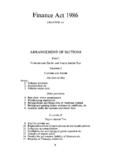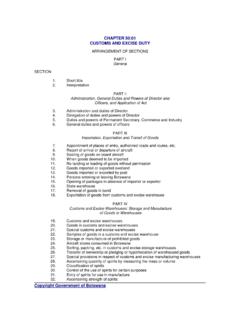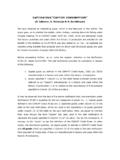Transcription of URAtaxationGuide Nov2011 CS2 - A.H. THAKKAR
1 KTAXATION HANDBOOK A Guide to Taxation in UgandaTAXATION HANDBOOKA PUBLICATION OFUganda Revenue Authority,Public and Corporate Aff airs Division,P. O. BOX 7279, Kampala, : 0417 442054/5 or 0417 443150 URA Toll free help line: 08001 17000 Email: Web portal: Guide to Taxation in Uganda TAXATION HANDBOOKA Guide to Taxation in UgandaA Publication ofUganda Revenue AuthorityFOUNTAIN PUBLISHERSK ampalaFountain PublishersP. O. Box 488 KampalaE-mail: in Europe and Commonwealth countries outside Africa byAfrican Books Collective O. Box 721 Oxford OX1 9EN, UKEmail: Uganda Revenue Authority 2011 First published 2011 All rights reserved. No part of this publication may be reprinted or reproduced or utilised in any form or by any means, electronic,mechanical or other means now known or hereafter invented, including copying and recording, or in any information storage or retrieval system,without permission in writing from the , design: Robert Asaph Sempagala-MpagiISBN 978-9970-02-977-8 Cataloguing-in-Publication DataTaxation Handbook: A Guide to Taxation in Uganda Kampala: Fountain Publishers, 2011__ p; __ tablesISBN 978-9970-02-977-81.
2 Guide to Taxation iiiiiiForeword ..viiPart A Background to Taxation ..11 Introduction to of Taxation Legality of Taxes y of Taxes Collected by the Centhe Central Government ..64 Principles of of of of Taxation ..118 Structure of the Ugandan Tax on B Income Tax .. of Key of URA Toll-free Help line 0800-117000iviv6 Determination of Tax assessable to Tax of Income .. 5210 Income Tax Clearance Certificate ..561111 Assessments ..5712 Objections and Appeals under Income Withholding Tax System ..60 Part C Value Added Tax (VAT)..671 Background ..692 Definition of Key Te r m of VAT ..714 VAT Registration ..725 Supply of Goods and Services.
3 81816 Calculation of Return and Payment of A s s e s s m e and Appeals ..961111 VAT Refund ..9712 Administrative vPart D Local Excise Excise x able (waiver) of Excise and Computation/Tax Rattion/Tax ENon-Tax Revenue (NTR)..1091 Non-Tax Revenue (NTR)..1112 Stamp FCustoms .. of Key Procedures ..1285 Clearance of Passengers and Baggage ..1326 Exemptions under the Fifth Schedule of URA Toll-free Help line 0800-117000vivi9 Computation of Import and GSpecial Features of the Taxes Administered by the of .. 1464 Remission of Tax ..1475 Double Taxation Treaties .. 1476Ta x p aye r s C h a r t 147 160 Foreword viiviiI am glad to introduce to you the Ta x a tion Handbook: A Guide to Taxation in Uganda.
4 The handbook has been developed as a guide to our stakeholders in line with the administration of central government taxes in Uganda. The main objective of this handbook is to provide information and serve as reference material for all our stakeholders to include the academic fraternity. It has been put together by a taskforce of the Uganda Revenue Authority in conjunction with the National n conjunction with the National Curriculum Develo Development hais handbook comes at a time when taxation as aa subject has been introduced not only in tertiary institutions, but also in primary and secondary schools. Since everyone, in one way or another pays taxes, it is crucial that we come up with a handbook that will offer answers to the numerous questions on taxation raised by the general public.
5 The handbook clearly outlines the structure of he different taxes that are paUganda s tax system, the different taxes that are paid xpayer s obligations as well as different ways and the taxpayer s obligations as well as different ways which the aggrieved taxpayer may seek redress. in which The handbook seeks to simplify the laws which govern taxation, for the benefit of our stakeholders and the academic fraternity. I hope that this handbook, which comes as a key complementary document to the taxation-related laws of Uganda, will help to generate a better understanding of taxation. URA Toll-free Help line 0800-117000viiiviiiOn behalf of the Uganda Revenue Authority, I would like to express our sincere gratitude to all those individuals, organisations and institutions that have played a key role in producing this handbook.
6 In particular we recognize the development partners who sponsored the curriculum development in schools and the staff of URA for their contribution to the Uganda together,Allen Kagina Commissioner General Uganda Revenue Authority Part A Background to Taxation 11 Part A Background to Taxation gg Part A Background to Taxation Background to Taxation331 Introduction to TaxationThe evolution of taxation is attributed to the development of the modern state, which led to increased expenditure for infrastructure and public services. of TaxationTax is the price we pay for civilization, which goes pay for civilization, which goes hand in hand withnd with organized society.
7 For society to be organizeganized, it needs a well-financed administrative strucstructure. Therefore, taxation in its different forms has existed as long as society had the minimum elements of government. Tax is defined as a monetary charge imposed by the government on persons, entities, transactions or property to yield public revenue. Where payment is not monetary, a more wide embracing definition has been adopted as:nforced proportional contributions Taxes are the enforced proportional contributions m persons and property levied by the State from personsby virtue of its sovereignty for the support of by vgovernment and for all public needs (Thomas.)
8 M. Cooley:The Law of Ta x a t i on). One of the main characteristics of a tax is that the payer does not demand something equivalent in return from the government for the payment. It is expected that when taxes are collected, they are used by government for public good and not just for those who make the payment. Background to Taxation URA Toll-free Help line 0800-117000 Taxation Handbook42 History of Taxation in East AfricaTaxation as understood today was introduced in East Africa by the early British colonial administrators through the system of compulsory public works such as road construction, building of administrative headquarters and schools, as well as forest clearance and other similar works.
9 The first formal tax, the hut tax, was introduced in 1900. This is when the first common tariff arrangements were established between Kenya and Uganda. Through this, Ugandans started paying customs duty as an indirect tax, which involved imposition of anad valoremimport duty at a rate of 5% on all goods entering East Africa, through the port of Mombasa and destined for Uganda. A similar arrangement was subsequently made with German East Africa (Tanganyika) for goods destined for Uganda that entered East Africa through Dar-es-Salaam and Tanga ports. This gave rise to revenue e which was remitted to Uganda.
10 The Protectorate government heavily relied on cucustoms duties to fund its programs, yet the indigenousous Africans were not engaging in activities that wowould propel the growth of the monetary economymy. Accordingly, government introduced a flat rate pe poll tax that was imposed on all male adults. The reqrequirement to pay tax forced the indigenous Ugandanans to enter the market sector of the economy throhrough either selling their agricultural produce or hiring out their services. The hiring out their services. The tax burden was later increased by the introduction of ncreased by the introduction o Part A Background to Taxation Background to Taxation5an additional tax to finance local governments.







